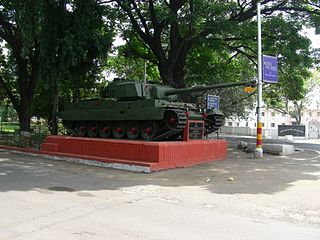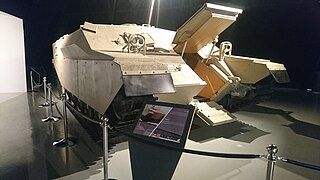
The FV4034 Challenger 2 is a third generation British main battle tank (MBT) in service with the armies of the United Kingdom, Oman, and Ukraine.

The T-72 is a family of Soviet main battle tanks that entered production in 1973. The T-72 was a development based on the T-64 using thought and design of the previous Object 167M. About 25,000 T-72 tanks have been built, and refurbishment has enabled many to remain in service for decades. It has been widely exported and has seen service in 40 countries and in numerous conflicts. The Russian T-90 introduced in 1992 and the Chinese Type 99 are further developments of the T-72. Production and development of various modernized T-72 models continues today.

The T-62 is a Soviet main battle tank that was first introduced in 1961. As a further development of the T-55 series, the T-62 retained many similar design elements of its predecessor including low profile and thick turret armour.

The M48 Patton is an American first-generation main battle tank (MBT) introduced in February 1952, being designated as the 90mm Gun Tank: M48. It was designed as a replacement for the M26 Pershing, M4 Sherman, M46 and M47 Patton tanks, and was the main battle tank of the U.S. Army and U.S. Marine Corps in the Vietnam War. Nearly 12,000 M48s were built, mainly by Chrysler and American Locomotive Company, from 1952 to 1961. The M48 Patton was the first U.S. medium gun tank with a four-man crew, featuring a centerline driver's compartment and no bow machine gunner. As with nearly all new armored vehicles it had a wide variety of suspension systems, cupola styles, power packs, fenders and other details among individual tanks.

The M47 Patton was an American medium tank, a development of the M46 Patton mounting an updated turret, and was in turn further developed as the M48 Patton. It was the second American tank to be named after General George S. Patton, commander of the U.S. Third Army during World War II and one of the earliest American advocates of tanks in battle.

The M60 is an American second-generation main battle tank (MBT). It was officially standardized as the Tank, Combat, Full Tracked: 105-mm Gun, M60 in March 1959. Although developed from the M48 Patton, the M60 tank series was never officially christened as a Patton tank. It has been called a "product-improved descendant" of the Patton tank's design. The design similarities are evident comparing the original version of the M60 and the M48A2. The United States fully committed to the MBT doctrine in 1963, when the Marine Corps retired the last (M103) heavy tank battalion. The M60 tank series became America's primary main battle tank during the Cold War, reaching a production total of 15,000 M60s. Hull production ended in 1983, but 5,400 older models were converted to the M60A3 variant ending in 1990.

The FV4007 Centurion was the primary British Army main battle tank of the post-World War II period. Introduced in 1945, it is widely considered to be one of the most successful post-war tank designs, remaining in production into the 1960s, and seeing combat into the 1980s. The chassis was adapted for several other roles, and these variants have remained in service. It was a very popular tank with good armour, mobility, and a powerful main armament.

The Comet tank or Tank, Cruiser, Comet I (A34) was a British cruiser tank that first saw use near the end of the Second World War, during the Western Allied invasion of Germany. The Comet was developed from the earlier Cromwell tank with a lower profile, partly-cast turret which mounted the new 77 mm HV gun. This was a smaller version of the 17 pdr anti-tank gun firing the same 76.2 mm (3") projectiles, albeit with a lighter charge, and was effective against late-war German tanks, including the Panther and Tiger.

The Ratel is a South African infantry fighting vehicle. It was the first wheeled infantry fighting vehicle to enter service worldwide and was built on a modified MAN truck chassis. The Ratel was designed in response to a South African Army specification for a light armoured vehicle suited to the demands of rapid offensives, providing maximum firepower and strategic mobility to mechanised infantry units intended to operate across the vast distances of Southern Africa. Primarily envisaged in SADF doctrine as a vehicle that could deliver mechanised infantry and supporting fire to tanks in conventional warfare, it was also anticipated that the Ratel could form the centrepiece for semi-independent battlegroups where logistics or politics precluded the use of tanks. The Ratel was a simple, economical design which helped reduce the significant logistical commitment necessary to keep heavier combat vehicles operational in undeveloped regions. It was generally regarded as an influential concept which incorporated a number of novel features, such as a mine-protected hull, an extended operating range of 1,000 kilometres, and a 20 mm autocannon fitted with what was then a unique twin-linked ammunition feed, allowing turret gunners to rapidly swap between ammunition types during combat.

The Arjun is a third generation main battle tank developed by the Combat Vehicles Research and Development Establishment (CVRDE) of the Defence Research and Development Organisation (DRDO), for the Indian Army. The tank is named after Arjuna, the archer prince who is the main protagonist of the Indian epic poem Mahabharata. Design work began in 1986 and was finished in 1996. The Arjun main battle tank entered service with the Indian Army in 2004. The 43rd Armoured Regiment, formed in 2009, was the first regiment to receive the Arjun.

The Type 90 tank is a main battle tank (MBT) of the Japan Ground Self-Defense Force (JGSDF). It was designed and built by Mitsubishi Heavy Industries as a replacement for the Type 61 and to supplement the then current fleet of Type 74 tanks, and entered service in 1990.

The Type 96 or ZTZ96 is a Chinese second generation main battle tank (MBT). The final evolution of the Type 88 design, the Type 96 entered service with the People's Liberation Army (PLA) in 1997. The later variants of the Type 96 are currently in PLA service together with China's third generation MBT, the Type 99.

The FV4030/4 Challenger 1 is a British main battle tank (MBT) used by the British Army from 1983 to 2001, when it was superseded by the Challenger 2. The majority of the Challenger 1 fleet was subsequently sold to Jordan where it remained in service with the Royal Jordanian Army until withdrawals were announced in 2018. Known locally as Al-Hussein, these vehicles received various Jordanian modifications before being replaced by French-made Leclerc tanks from the UAE and ex-Italian B1 Centauro 8x8 wheeled tank destroyers. The Jordanian Challenger 1 fleet had been retired by January 2023.

The FV4201 Chieftain was the main battle tank (MBT) of the United Kingdom from the 1960s into 1990s. When introduced, it was among the most heavily armed MBTs of the era, mounting a 120 mm Royal Ordnance L11 gun, the equal of the much larger specialist heavy tanks then in service. It also was among the most heavily armoured, with up to 195 mm (7.7 in) that was highly sloped to offer 388 mm (15.3 in) thickness along the line of sight.

The Vickers MBT is a series of main battle tanks (MBTs) developed as a private venture by British company Vickers-Armstrongs for export. The design makes use of proven components, such as the L7 gun of the Centurion, the Leyland L60 multi-fuel engine, the transmission and fire control system of the Chieftain. A variant was built under licence in India as the Vijayanta, and served with the Indian Army.

The Panhard EBR is an armoured car designed by Panhard for the French Army and later used across the globe, notably by the French Army during the Algerian War and by the Portuguese Army during the Portuguese Colonial War.

The Charioteer Tank, or FV4101 Tank, Medium Gun, Charioteer was a post-world-war II British armoured fighting vehicle. It was produced in the 1950s to up-gun units of the Royal Armoured Corps continuing to use the Cromwell tank during the early phases of the Cold War. The vehicle itself was a modified Cromwell with a more powerful gun installed in a relatively lightly armoured two-man turret.

A main battle tank (MBT), also known as a battle tank or universal tank or simply tank, is a tank that fills the role of armour-protected direct fire and maneuver in many modern armies. Cold War-era development of more powerful engines, better suspension systems and lighter composite armour allowed for the design of a tank that had the firepower of a super-heavy tank, the armour protection of a heavy tank, and the mobility of a light tank, in a package with the weight of a medium tank. The first designated MBT was the British Chieftain tank, which during its development in the 1950s was re-designed as an MBT. Throughout the 1960s and 1970s, the MBT replaced almost all other types of tanks, leaving only some specialist roles to be filled by lighter designs or other types of armoured fighting vehicles.

Dawsar or MAP II is a heavily armored personnel carrier developed by King Abdullah Design and Development Bureau. It is based on Tariq main battle tank, an upgraded version of Centurion. The Jordanian Army received four of these vehicles in 2014.



















